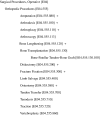Orthopaedic literature and MeSH
- PMID: 20623263
- PMCID: PMC3049625
- DOI: 10.1007/s11999-010-1387-4
Orthopaedic literature and MeSH
Abstract
Background: Since 1916 there has been a recognized demand for a method of classification of orthopaedic literature inclusive enough to permit the proper collection and retrieval of all literature on the subject. Today, MEDLINE, available through the PubMed interface, has become the de facto standard for organization and retrieval of medical literature. The Medical Subject Headings (MeSH), used to provide indexing and assist in searching, are partly responsible for this standard. Understanding how MeSH is built and maintained may lead the user to a better understanding of how to use MEDLINE, and what to expect from the indexing of an article.
Questions/purposes: The purpose of this review is to provide an understanding of the organization of large quantities of indexed material, the indexing process and the considerations involved in developing an indexing vocabulary. WHERE ARE WE NOW?: Successful terminology development and use, a prerequisite for any sharing of information by electronic means, depends on both user (how the user is expected to use the system) and information (how the information is organized) models. MEDLINE has a simple user model and a simpler information model. The user is expected to determine what is relevant and which MeSH descriptors are appropriate. WHERE DO WE NEED TO GO?: While MEDLINE through PubMed is a success as viewed by the number of hits, further improvements will depend on better, faster indexing with a controlled terminology. Terminology development requires careful consideration of the nature of the subject, how users employ the terminology, the overall purpose of the terminology, and the framework of the systems in which it is used. HOW DO WE GET THERE?: For the future, understanding terminology development might enable the user to comprehend some of the issues involved in sharing of other information by electronic means. Further improvements in the availability and accessibility of medical literature will depend on continued maintenance and development of MeSH, as well as on refinement of the indexing process.
Figures
Similar articles
-
Quality of pharmacy-specific Medical Subject Headings (MeSH) assignment in pharmacy journals indexed in MEDLINE.Res Social Adm Pharm. 2015 Sep-Oct;11(5):686-95. doi: 10.1016/j.sapharm.2014.11.004. Epub 2014 Nov 22. Res Social Adm Pharm. 2015. PMID: 25498253
-
A MEDLINE categorization algorithm.BMC Med Inform Decis Mak. 2006 Feb 7;6:7. doi: 10.1186/1472-6947-6-7. BMC Med Inform Decis Mak. 2006. PMID: 16464249 Free PMC article.
-
Reflective random indexing for semi-automatic indexing of the biomedical literature.J Biomed Inform. 2010 Oct;43(5):694-700. doi: 10.1016/j.jbi.2010.04.001. Epub 2010 Apr 9. J Biomed Inform. 2010. PMID: 20382265
-
MEDLINE and MeSH: challenges for end users.Med Ref Serv Q. 1992 Fall;11(3):29-46. doi: 10.1300/J115V11N03_03. Med Ref Serv Q. 1992. PMID: 10122123 Review.
-
The Need to Improve the Medical Subject Headings (MeSH) and the Excerpta Medica Tree (EMTREE) Thesauri to Perform Systematic Review on Oral Potentially Malignant Disorders.J Oral Pathol Med. 2025 Apr;54(4):241-247. doi: 10.1111/jop.13616. Epub 2025 Mar 9. J Oral Pathol Med. 2025. PMID: 40059391 Free PMC article.
Cited by
-
CBGDA: a manually curated resource for gene-disease associations based on genome-wide CRISPR.Database (Oxford). 2024 Aug 30;2024:baae077. doi: 10.1093/database/baae077. Database (Oxford). 2024. PMID: 39213392 Free PMC article.
-
Detection and characterization of translational research in cancer and cardiovascular medicine.J Transl Med. 2011 May 11;9:57. doi: 10.1186/1479-5876-9-57. J Transl Med. 2011. PMID: 21569299 Free PMC article.
-
Predicting Surgical and Non-surgical Curvature Correction by Radiographic Spinal Flexibility Assessments for Patients With Adolescent Idiopathic Scoliosis: A Systematic Review and Meta-Analysis.Global Spine J. 2025 Jun;15(5):2822-2838. doi: 10.1177/21925682251319543. Epub 2025 Feb 20. Global Spine J. 2025. PMID: 39980162 Free PMC article. Review.
-
Analysis of the human diseasome using phenotype similarity between common, genetic, and infectious diseases.Sci Rep. 2015 Jun 8;5:10888. doi: 10.1038/srep10888. Sci Rep. 2015. PMID: 26051359 Free PMC article.
-
Aber-OWL: a framework for ontology-based data access in biology.BMC Bioinformatics. 2015 Jan 28;16:26. doi: 10.1186/s12859-015-0456-9. BMC Bioinformatics. 2015. PMID: 25627673 Free PMC article.
References
-
- Aronson AR, Mork JG, Gay CW, Humphrey SM, Rogers WJ. The NLM Indexing Initiative’s Medical Text Indexer. Stud Health Technol Inform. 2004;107(Pt 1):268–272. - PubMed
-
- Barnett O. Assisting health professions education through information technology. Past, Present, and Future of Biomedical Information. Bethesda, MD: National Library of Medicine; 1987. NIH Publication No 88-2911, pp 88–103.
-
- Classification of orthopedic literature. Am J Orthop Surg. 1916;14:613–617.
Publication types
MeSH terms
LinkOut - more resources
Full Text Sources



